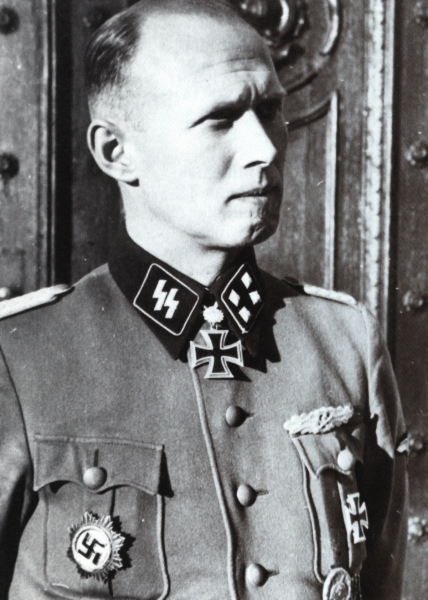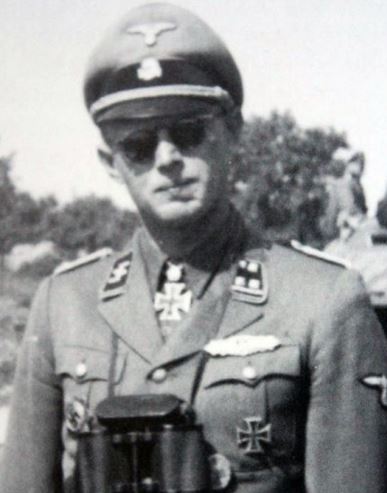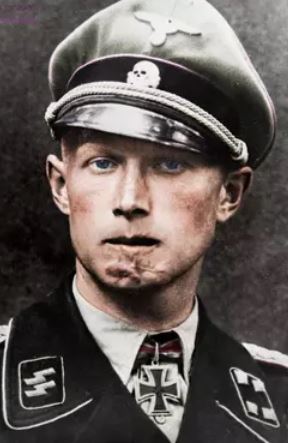Tychsen, Christian (Waffen SS)
- Date of birth:
- December 3rd, 1910 (Flensburg/Schleswig-Holstein, Germany)
- Date of death:
- July 28th, 1944 (Trelly, Crossroad St. Denis-Gavray/Normandy, France)
- Buried on:
- German War Cemetery Marigny
Plot: 5. Row: 24. Grave: 1196. - Service number:
- SS-Nr.: 23.821 // NSDAP-Nr.: 957.587
- Nationality:
- German
Biography
Promotions:
00.00.1936: SS-Oberscharführer
30.01.1937: SS-Untersturmführer
01.06.1938: SS-Obersturmführer
09.11.1939: SS-Hauptsturmführer
01.09.1942: SS-Sturmbannführer
30.01.1944: SS-Obersturmbannführer
Career:
00.12.1931: entered the SS in the SS-Standarte 50
00.10.1934: joined the SS-VT
01.09.1936: SS-Sturmbann 'Nürnberg'
00.10.1936-00.12.1938: SS-Ustuf, Zugführer, I. Sturmbann, SS-Standarte 'Germania', SS-VT
30.01.1937-10.06.1939: SS-Ustuf, Zugführer, I. Zug, 2. Sturm, SS-Sturmbann 'Nürnberg'
00.12.1938: SS-Ostuf, Führer, 2. Sturm, SS-Sturmbann 'Nürnberg'
10.06.1939-10.03.1941: SS-Ostuf, Führer, 1. Kompanie, SS-Panzer-Abwehr-Abteilung
00.05.1940: SS-Hstuf, Chef, 1. Kradschützen-Kompanie, SS-VT
10.03.1941-14.02.1942: SS-Hstuf, Chef, 3. Kompanie, SS-Kradschützen-Abteilung, SS-Division 'Reich'
14.02.1942-05.04.1942: SS-Hstuf, WIA and evacuated to a Lazarett - SS-Kradschützen-Ersatz-Bataillon
05.04.1942-27.05.1942: SS-Hstuf, Lehrer, SS-Junkerschule Braunschweig
27.05.1942-21.10.1942: SS-Hstuf, Führer, SS-Infanterie-Regiment 2 'Langemarck', SS-Division 'Reich'
21.10.1942: SS-Stubaf, Führer, I. Abteilung, SS-Panzer-Regiment 2 (renaming), 2. SS-Panzergrenadier-Division 'Das Reich'
24.10.1942-14.11.1942: Abteilungskommandeur-Lehrgang, Panzertruppenschule Wûnsdorf
00.11.1943: SS-Stubaf, Führer, SS-Panzer-Regiment 2, 2. SS-Panzergrenadier-Division 'Das Reich'
24.07.1944-28.07.1944: SS-Ostubaf, temp. Führer, 2. SS-Panzergrenadier-Division 'Das Reich'
28.07.1944: SS-Ostubaf, severely WIA by a US tank shot during a reconnaissance with his Kübelwagen at the crossroad between Saint Denis and Gavray in Normandie, France and evacuated to a US field hospital where DOW the same day
Some reports indicate all his belongings including his dog tags were stolen and was firstly burried as an unkonwn soldier and only later identificated and burried at Marigny, France
Do you have more information about this person? Inform us!
- Period:
- Second World War (1939-1945)
- Rank:
- SS-Hauptsturmführer (Captain)
- Unit:
- Chef, 3. Kradschützen-Kompagnie, SS-Aufklarungs-Abteilung, SS-Verfügungs-Division
- Awarded on:
- May 30th, 1940
- Period:
- Second World War (1939-1945)
- Rank:
- SS-Hauptsturmführer (Captain)
- Unit:
- Chef, 3. Kradschützen-Kompagnie, Aufklarungs-Abteilung, SS-Verfügungs-Division
- Awarded on:
- July 18th, 1940
- Period:
- Second World War (1939-1945)
- Rank:
- SS-Hauptsturmführer (Captain)
- Unit:
- Chef, 3. Kompanie, SS-Kradschützen-Abteilung, SS-Division 'Reich'
- Awarded on:
- July 3rd, 1941
- Period:
- Second World War (1939-1945)
- Rank:
- SS-Hauptsturmführer (Captain)
- Unit:
- Chef, 3. Kompanie, SS-Kradschützen-Abteilung, SS-Division 'Reich'
- Awarded on:
- July 30th, 1941
- Period:
- Second World War (1939-1945)
- Rank:
- SS-Hauptsturmführer (Captain)
- Unit:
- Chef, 3. Kompanie, SS-Kradschützen-Abteilung, SS-Division 'Reich'
- Awarded on:
- November 20th, 1941
- Period:
- Second World War (1939-1945)
- Rank:
- SS-Hauptsturmführer (Captain)
- Unit:
- Chef, SS-Kradschützen-Bataillon "Das Reich"
- Awarded on:
- February 12th, 1942
- Period:
- Second World War (1939-1945)
- Rank:
- SS-Hauptsturmführer (Captain)
- Unit:
- Chef, SS-Kradschützen-Bataillon "Das Reich"
- Awarded on:
- May 30th, 1942
Award 115/2.
Date according the "Vorschlag" to the Ritterkreuz, in the "Vorschlag" to the Eichenlaub the date for the DKiG states May 13th 1942.
- Period:
- Second World War (1939-1945)
- Rank:
- SS-Hauptsturmführer (Captain)
- Unit:
- Führer, SS-Kradschützen-Abteilung, SS-Division 'Reich'
- Awarded on:
- August 20th, 1942
- Period:
- Second World War (1939-1945)
- Rank:
- SS-Sturmbannführer (Major)
- Unit:
- Kommandeur, II. Abteilung, SS-Panzer-Regiment 2, 2. SS-Panzergrenadier-Division "Das Reich", Armee-Abteilung "Kempf", Heeresgruppe Süd
- Awarded on:
- March 31st, 1943
“On the 11.02.1943 SS-Sturmbannführer Tychsen executed a deliberate counterattack with a force consisting of his Abteilung (16 Panzers strong at the time) as well as 1 Bataillon of the 213. Sicherungs-Division. The aim of this counterattack was to recapture the village of Priwolje, located east of Kharkov. During this counterattack his skillful leadership and inspiring boldness led to the destruction of a strong enemy battlegroup that was trying to punch its way through to Kharkov.
In this battle Tychsen first ordered his infantry to avoid battle with the enemy before striking the pursuing enemy forces with his Panzers. When these enemy forces began to flee the field he pursued them and totally annihilated them. Throughout this engagement he conducted the battle from his command Panzer in the foremost line, and in the process it was knocked out by 3 anti-tank gun hits.
On the 18.02.1943 SS-Sturmbannführer Tychsen and his Abteilung were assigned a new mission. The Division planned to fight its way through Kharkov and exit the city via the southwest during the following night, however strong enemy forces had occupied territory along the northwestern edge of Kharkov. In order to safeguard his own Division’s advance, Tychsen was to advance along the city’s edge and destroy those enemy forces. At this same time the enemy had also already penetrated into the southeastern part of the city.
Whilst reconnoitring the area Tychsen determined that the enemy had already made deep inroads into the city itself, and so he made the risky decision to enter the western part of the city and engage the enemy in urban combat despite the lack of supporting friendly infantry. He reasoned that this was the only possible way to prevent a further enemy advance into the centre of the city, which would in turn encircle the Division while it was still east of Kharkov.
After eliminating numerous anti-tank guns Tychsen led his Abteilung into the city before proceeding to smash multiple strong enemy columns that he encountered. During the following night Tychsen and his Abteilung sealed off those areas of the city the enemy had occupied and covered the withdrawal of the Division.
This independent initiative that SS-Sturmbannführer Tychsen demonstrated here (namely to risk his Panzer-Abteilung in urban combat) as well as his ruthlessness in carrying out this plan enabled the Division to disengage from the foe and pull out through Kharkov. He thus prevented the encirclement of the Division, and by extension the high losses in weapons and equipment that could not have been avoided given this outcome.
SS-Sturmbannführer Tychsen is a tough soldier who demands the utmost of both himself and his troops. In 1942 he was awarded the German Cross in Gold after his numerous displays of personal bravery. By that time he had been wounded no less than 5 times in this war.
He is particularly worthy of bearing the Knight’s Cross.”
1627th Award.
Submitted on March 1st 1943.
Preliminary document and decoration on April 3rd 1943 to Heeresgruppe Süd.
The "Vorschlag" for the Eichenlaub, states as the award date for the Ritterkreuz April 1st 1943.
- Period:
- Second World War (1939-1945)
- Rank:
- SS-Sturmbannführer (Major)
- Awarded on:
- November 1943
- Period:
- Second World War (1939-1945)
- Awarded on:
- November 1943
- Period:
- Second World War (1939-1945)
- Awarded on:
- November 1943
- Period:
- Second World War (1939-1945)
- Awarded on:
- November 1943
- Period:
- Second World War (1939-1945)
- Rank:
- SS-Sturmbannführer (Major)
- Unit:
- Kommandeur, II. Abteilung, SS-Panzer-Regiment 2, 2. SS-Panzergrenadier-Division "Das Reich", Armee-Abteilung "Kempf", Heeresgruppe Süd
- Awarded on:
- December 10th, 1943
“On the 29.10.1943 the left wing of the XXXXVIII. Panzer-Korps launched an attack that sought to eliminate the enemy’s bridgehead west of Chodoroff (in the Dnieper bend), however it did not meet with success. Thus, on the 01.11.1943, the Russians attacked out of this bridgehead at multiple locations following a half-hour artillery drumfire. The hostile intent was to break through the weak friendly defensive front and unite their two bridgeheads in the area. Once this had been achieved they hoped to launch a further thrust that would reach the road at Pij.
All the enemy’s massive tank-supported attacks in the sector of the Division itself were defeated in fierce combat. However in the sector of the right-neighbouring Division the Russians succeeded in seizing Hill 188.0 with a force of 16 tanks plus strong infantry elements. From this point they had a commanding view of the villages of Greschewo and Dudari, both of which were the sites of bitter fighting along the left wing of the neighbouring Korps at the time.
At the time the III. Artillerie-Abteilung (Sfl.) of the Division ‘Das Reich’ was assigned to the neighbouring Division, and by swiftly sealing off the enemy’s penetration towards the south it was able to prevent any immediate hostile advance towards Gruschewo. However the danger to both the right wing of the Division as well as the open flank of the neighbouring Korps’ eastern front was still far from resolved.
At this time SS-Sturmbannführer Tychsen and his depleted Panzer-Abteilung were involved in difficult defensive combat, however in spite of this he [Tychsen] made the decision to remove a Panzer VI, 3 Panzer IVs and a Pionier-Zug from his line of battle in order to strike this new enemy force in its deep flank. This weak armoured group launched a bold attack that managed to seize control of Hill 188.0. With this result the Russians were simultaneously prevented from pressing their attack with powerful new infantry units. In this engagement Tychsen personally knocked out 2 of the 3 T-34s that entered the battle. Afterwards he placed himself at the head of his handful of Pioniere and eliminated the enemy position in close combat. In this fighting the Panzers gave covering fire and destroyed a further 6 enemy tanks. The Russian battalion that had made it onto Hill 188.0 was completely smashed.
The infantry from the neighbouring Division then once again occupied Hill 188.0. With this the critical situation for the left wing of the neighbouring Korps was eliminated.
SS-Sturmbannführer Tychsen has the honour of having mastered this particular situation. Success here would have been impossible without his fearlessness, martial example and above all his independent decision to help his hard-pressed neighbour. The enemy losses were so heavy that they pulled back to the north. On the evening of the 01.11.1943 the position was once again in the hands of the neighbouring Division.
SS-Sturmbannführer Tychsen is a well-renowned SS-leader whose reputation goes beyond the ranks of just the Division itself. In the fighting that took place this summer he was the soul of the armoured combat. He led his Abteilung to great successes in both attack and defense. Throughout this time he repeatedly distinguished himself through his decisiveness, responsibility and exemplary bravery.
Tychsen brought about particularly notable victories on the 08.07.1943 (during the thrust of the divisional Panzergruppe to the Psel river) and on the 01.08.1943 (near Marinowka on the Mius river). On the same day [the 01.08.1943?] his Abteilung supported the extremely difficult defensive combat of SS-Panzergrenadier-Regiment ‘Der Führer’, which had to withstand 17 enemy attacks. In this time Tychsen also distinguished himself through his personal devotion to duty.
During the retreat to the Dnieper Tychsen and his Abteilung received the mission of counterattacking the enemy with the handful of still operational AFVs in order to enable the Panzergrenadiers to successfully disengage. Tychsen conducted this mission (carried out over the course of several days) with great courage. In this time he succeeded in bringing his knocked out Panzer to safety whilst in full view of the enemy. His Abteilung has a high share in the great successes of the Division’s Panzer-Regiment.
To me it appears that SS-Sturmbannführer Tychsen’s soldierly personality and singular battlefield achievements are particularly worthy of being recognized with the high award of the Oakleaves to the Knight’s Cross of the Iron Cross.”
353rd Award.
Submitted on December 2nd 1943.
Sources
- Photo 1: Wilco Vermeer
- Photo 2:
- Photo 3:
- Photo: Wilco Vermeer collection, the Netherlands
- - MOONEY, PETER, Waffen-SS Knights and their Battles, Schiffer Publishing, Ltd, 2010.
- MOONEY, PETER, Waffen-SS Knights and their Battles, Schiffer Publishing, Ltd., 2012.
- Die Ordensträger der Deutschen Wehrmacht (CD), VMD-Verlag GmbH, Osnabrück, 2002
- Kwasny A., Kwasny G., Die Eichenlaubträger 1940-1945 (CD), Deutsches Wehrkundearchiv, Lage-Waddenhausen, 2001
- Fellgiebel W.P., Elite of the Third Reich, The recipients of the Knight's Cross of the Iron Cross 1939-1945: A Reference, Helion & Company Limited, Solihull, 2003, ISBN 1-874622-46-9
- Patzwall K., Scherzer V., Das Deutsche Kreuz 1941-1945, Geschichte und Inhaber Band II, Verlag Klaus D. Patzwall, Norderstedt, 2001, ISBN 3-931533-45-X
- Federl, C., Die Ritterkreuzträger der Deutschen Panzerdivisionen 1939-1945, VDM Heinz Nickel, Zweibrücken, Germany, 2000
- Die träger des Ritterkreuzes des Eiserne Kreuz 1939 - 1945
- Das Reich
- Lexikon der Wehrmacht
- Axis Biographical Research
- Ritterkreuztraeger.info
- Microfilm Publication A3343. US National Archives




















